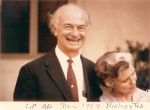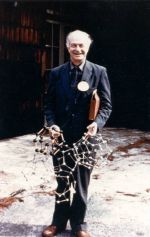
Middle Years: War Work, Peace Work and Protein Structure
Page 5-3
| 1960s | Peace activism Pauling continued to speak out for peace and against the arms race in the 1960s, especially the early part of the decade, in speeches, articles for and letters to scientific journals, political journals, and popular magazines, and testimony. He became an object of suspicion and of FBI investigation, and was accused of Communism and required to appear before a U.S. Senate investigatory committee, where he refused to supply the names of persons who helped him circulate a test-ban petition.
Typical titles:These articles, letters and lectures may be found in the print and online versions of the Catalogue by going to the Publications or Speeches section, where titles are listed in chronological order.  Ava Helen and Linus Pauling at the 7th Pugwash Conference, Stowe, Vermont, 1961. LP Photographs, 1961i.8 |
| 1962 | Nobel Prize for Peace The 1962 Peace Prize was announced in 1963 on the day a limited test-ban treaty went into effect (October 10th). This prize meant more to him, Pauling said, than any of his other awards, because of the moral content of the work that it recognized. It made him the sole person to have been awarded two unshared Nobel prizes. View Online:Nobel Prize for Peace Medal  Linus and Ava Helen Pauling at a Caltech Biology Department tea party held in honor of Linus's receipt of the Nobel Peace Prize, 1963. LP Photographs, 1963i.23 |
| 1964 | In his Nobel lecture of December 1963, "Science and Peace," Pauling asserted, "There
is no defense in science against the weapon which can destroy civilization." (White,
Linus Pauling, p.76).
View Online: Publications 1964p.6 (Catalogue Vol. I page 129) |
| 1960s | Research Notebooks Research notes from the 1960s appear in various notebooks. From Boxes 24R through 32R, notebooks dates vary, but mostly span 1950-1980s and a few 1990s, with some brief notes from the 1930s and 1940s here and there. 1960s contents include notes on the alpha helix, on the structure of nuclei, on boranes, on collagen, and on personal events. Notes from the 1960s may also be found in Boxes 35R- 37R and Box 46R. Topics include the chemical bond, alloys, electronegativity and diffraction data. See the print or online catalogue for listings of research notebook contents View Online: Research Notebooks Boxes 24R-32R; 35R-37R; 46R (Beginning with catalogue Vol. II page 106) |
| 1961 | "A molecular theory of general anesthesia" Pauling’s theory that certain anesthetics might affect the brain by aiding the formation of crystals that suppressed electrical activity was not borne out by the research carried out in his laboratory. A much-cited article. Publications 1961p.8 (Catalogue Vol. I page 125) |
| 1962 | "Molecular disease, evolution, and genic heterogeneity" Written with Emile Zuckerkandl. Established that the hemoglobin molecule could be used as an evolutionary clock, since changes in its amino acid sequences correlate with evolutionary divergence of species. Publications 1962p.23 (Catalogue Vol. I 127) |
| 1964 | "Nature of the iron-oxygen bond in oxyhaemoglobin" A much-cited paper. View Online: Manuscripts of Articles 1964a.13(Catalogue Vol. I 168) |
| 1964 | The Architecture of Molecules Discussions of chemistry, biology, and solid-state physics in a handsomely illustrated book with hand-drawn depictions of molecules by Roger Hayward. Some of the original drawings are in the Pauling collection. Compare the state of the art of showing molecular structure then with now; see the Appendix list of websites. Manuscripts and Typescripts of Books 9.003 (Catalogue Vol. I page 176) See also: Collection of Pauling’s handmade three-dimensional molecular models. Pauling began making models in 1927, first of paper and wire, then with plastic balls and sticks, and metal and wood. They aided him in what he called his "stochastic method" of visualizing possible structures imagined on a theoretical basis, following chemical principles applied to limited empirical data. Pauling’s models were an inventive methodology, now ubiquitous in molecular research. View Online:Models.  Linus Pauling holding molecular models of water based on the pentagonal dodecahedron, ca. 1960s. LP Photographs, 196?i.59 |
| 1965 | "Evolutionary divergence and convergence in proteins" Written with Emile Zuckerkandl. A much-cited paper. Publications 1965p.7 (Catalogue Vol. I page 130) |
| 1960s | Old and new interests In the same year that he was awarded the Nobel peace prize, 1963, Pauling resigned from CIT, and went on to The Center for the Study of Democratic Institutions to think on science, politics, and ethics. Of this period, Thomas Hager says (Force of Nature, p.558), "His only scientific tools now a pencil, paper, and slide rule, Pauling turned in the summer of 1965 to pure physics, working on a new theory of the structure of atomic nuclei." From the Center he went to visiting professorships at the University of California at San Diego, and at Stanford University. Pauling also developed an interest in vitamin therapy, influenced by Abram Hoffer and Humphry Osmond’s use of megavitamins to treat schizophrenia, and by his own use of vitamin C, begun in 1966 after communications with Irwin Stone, a biochemist convinced of vitamin C’s therapeutic properties. In the late 1960s Pauling began "synthesizing another great theory, a grand plan of the mind..." (Hager, p.568), his "orthomolecular psychiatry." |
Return to Ava Helen and Linus Pauling Papers Home
Table of Contents
- Introduction
- Ways to Approach the Curriculum
- Using Archival Materials in Special Collections
- Early Years: Education, Teaching and the Chemical Bond
- Middle Years: War Work, Peace Work and Protein Structure
- Part I: 1940-1949
- Part II: 1950-1959
- Part III: 1960-1965
- Later Years: Molecular Disease and Orthomolecular Medicine
- Topical Readings
- Websites Regarding Linus Pauling
- Appendix: General Guidelines for Use of Special Collections Materials
- Acknowledgements

